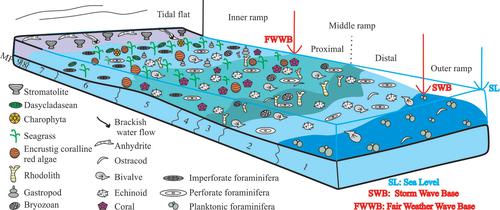当前位置:
X-MOL 学术
›
Acta Geol. Sinica Engl. Ed.
›
论文详情
Our official English website, www.x-mol.net, welcomes your
feedback! (Note: you will need to create a separate account there.)
Microfacies Analysis and Paleoecology of the Oligocene Succession in a Central Tethyan Carbonate Platform, Zagros Basin, SW Iran
Acta Geologica Sinica-English Edition ( IF 3.5 ) Pub Date : 2020-01-06 , DOI: 10.1111/1755-6724.14425 Tahereh HABIBI 1
Acta Geologica Sinica-English Edition ( IF 3.5 ) Pub Date : 2020-01-06 , DOI: 10.1111/1755-6724.14425 Tahereh HABIBI 1
Affiliation

|
Two stratigraphic sections (Arjooieh and Firoozabad) of the Mymand anticline, located in the Interior Fars sub-basin of the Zagros Mountains, were measured and sampled, in order to document sedimentological characteristics, microfacies types and paleo-seagrasses indicators of the Oligocene succession (Asmari Fm.). Planktonic and benthic foraminifera and coralline red algae are the principal fossils from these strata. Foraminifera are represented by the following families: Soritidae, Peneroplidae, Austrotrillinidae, Alveolinidae, Planorbulinidae, Discorbidae, Lepidocyclinidae, Amphisteginidae, Rotaliidae, Nummulitidae and Globigerinidae. Nine microfacies types were recognized, namely planktonic foraminifera-peloidal packstone (MF1), bioclast nummulitid/Nerorotalia/Amphistegina packstone-grainstone-rudstone-floatstone (MF2), Neorotalia-echinoid coralline red algae packstone-grainstone (MF3), coral boundstone (MF4), coral/coralline red algae rudstone-floatstone-packstone-grainstone (MF5), diverse imperforate foraminifera bioclast packstone-grainstone (MF6), peloid wackestone-packstone-grainstone (MF7), fenestrated mudstone and microbial mats (MF8) and anhydrite (MF9). MF1 indicates an outer ramp, MFs 2-4 represent a mid-ramp and MFs 5–9 are interpreted as inner ramp environment. Paleo-seagrass indicators consisting of foraminifera, hooked and tabular forms of coralline red algae and corals. They were identified in MFs 5 and 6, reflecting the presence of vegetated environments within the mid/inner ramp setting. The Mymand anticline was dominated by the outer ramp environment at the start of the Rupelian. Mid to inner ramp environments prevailed during the Rupelian. The Chattian corresponds to the spread of the inner ramp setting over the Mymand anticline.
中文翻译:

伊朗西南部扎格罗斯盆地中央特提斯碳酸盐岩台地渐新世序列的微相分析和古生态学
为了记录渐新世序列的沉积学特征、微相类型和古海草指标,对位于扎格罗斯山脉内部法尔斯次盆地的 Mymand 背斜的两个地层剖面(Arjooieh 和 Firoozabad)进行了测量和采样。阿斯马里调频。)。浮游和底栖有孔虫和珊瑚红藻是这些地层的主要化石。有孔虫由以下科代表:Soritidae、Peneroplidae、Austrotrillinidae、Alveolinidae、Planorbulinidae、Discorbidae、Lepidocyclinidae、Amphisteginidae、Rotaliidae、Nummulitidae 和 Globigerinidae。识别出 9 种微相类型,即浮游有孔虫-球状粉粒石 (MF1)、生物碎屑 nummulitid/ Nerorotalia/AmphisteginaPackstone-grainstone-rudstone-floatstone (MF2), Neorotalia-echinoid 珊瑚红藻粉砂岩-颗粒石 (MF3), 珊瑚粉砂石 (MF4), 珊瑚/珊瑚红藻粉砂石-浮石-粉砂石-颗粒石 (MF5), 各种无孔有孔虫生物碎屑粉砂石-颗粒石 (MF6), peloid wackestone-packstone-粒岩 (MF7)、有孔泥岩和微生物垫 (MF8) 和硬石膏 (MF9)。MF1 表示外部斜坡,MF 2-4 代表中间斜坡,MF 5-9 被解释为内部斜坡环境。古海草指标,包括有孔虫、珊瑚红藻和珊瑚的钩状和板状形式。它们在 MF 5 和 6 中被识别,反映了中/内坡道设置中植被环境的存在。Mymand 背斜以 Rupelian 开始时的外斜坡环境为主。中到内坡道环境在 Rupelian 期间盛行。
更新日期:2020-01-06
中文翻译:

伊朗西南部扎格罗斯盆地中央特提斯碳酸盐岩台地渐新世序列的微相分析和古生态学
为了记录渐新世序列的沉积学特征、微相类型和古海草指标,对位于扎格罗斯山脉内部法尔斯次盆地的 Mymand 背斜的两个地层剖面(Arjooieh 和 Firoozabad)进行了测量和采样。阿斯马里调频。)。浮游和底栖有孔虫和珊瑚红藻是这些地层的主要化石。有孔虫由以下科代表:Soritidae、Peneroplidae、Austrotrillinidae、Alveolinidae、Planorbulinidae、Discorbidae、Lepidocyclinidae、Amphisteginidae、Rotaliidae、Nummulitidae 和 Globigerinidae。识别出 9 种微相类型,即浮游有孔虫-球状粉粒石 (MF1)、生物碎屑 nummulitid/ Nerorotalia/AmphisteginaPackstone-grainstone-rudstone-floatstone (MF2), Neorotalia-echinoid 珊瑚红藻粉砂岩-颗粒石 (MF3), 珊瑚粉砂石 (MF4), 珊瑚/珊瑚红藻粉砂石-浮石-粉砂石-颗粒石 (MF5), 各种无孔有孔虫生物碎屑粉砂石-颗粒石 (MF6), peloid wackestone-packstone-粒岩 (MF7)、有孔泥岩和微生物垫 (MF8) 和硬石膏 (MF9)。MF1 表示外部斜坡,MF 2-4 代表中间斜坡,MF 5-9 被解释为内部斜坡环境。古海草指标,包括有孔虫、珊瑚红藻和珊瑚的钩状和板状形式。它们在 MF 5 和 6 中被识别,反映了中/内坡道设置中植被环境的存在。Mymand 背斜以 Rupelian 开始时的外斜坡环境为主。中到内坡道环境在 Rupelian 期间盛行。











































 京公网安备 11010802027423号
京公网安备 11010802027423号